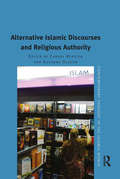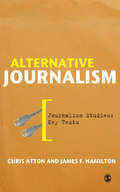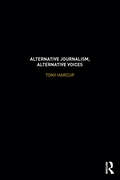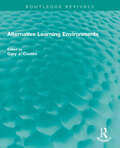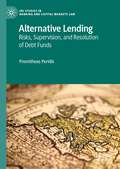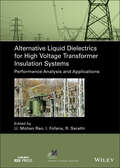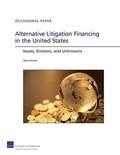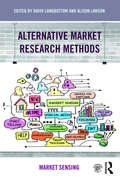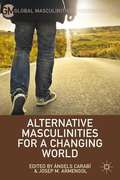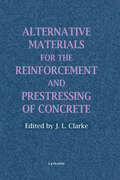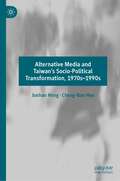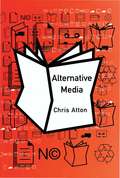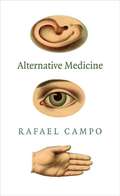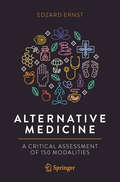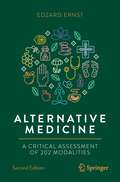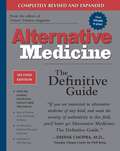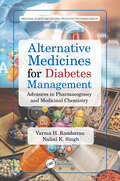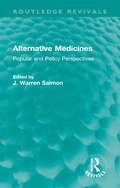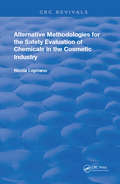- Table View
- List View
Alternative Islamic Discourses and Religious Authority (Contemporary Thought in the Islamic World)
by Carool Kersten Susanne OlssonLike anywhere else, the present-day Islamic world too is grappling with modernity and postmodernity, secularisation and globalisation. Muslims are raising questions about religious representations and authority. This has given rise to the emergence of alternative Islamic discourses which challenge binary oppositions and dichotomies of orthodoxy and heterodoxy, continuity and change, state and civil society. It also leads to a dispersal of authority, a collapse of existing hierarchical structures and gender roles. This book further argues that the centre of gravity of many of these alternative Islamic discourses is shifting from the Arabic-speaking 'heartland' towards the geographical peripheries of the Muslim world and expatriate Muslims in North America and Europe. At the same time, in view of recent seismic shifts in the political constellation of the Middle East, the trends discussed in this book hold important clues for the possible direction of future developments in that volatile part of the Muslim world.
Alternative Journalism (Journalism Studies: Key Texts)
by James F. Hamilton Chris AttonAlternative Journalism is the first book to investigate and analyse the diverse forms and genres of journalism that have arisen as challenges to mainstream news coverage. From the radical content of emancipatory media to the dizzying range of citizen journalist blogs and fanzine subcultures, this book charts the historical and cultural practices of this diverse and globalized phenomenon. This exploration goes to the heart of journalism itself, prompting a critical inquiry into the epistemology of news, the professional norms of objectivity, the elite basis of journalism and the hierarchical commerce of news production. In investigating the challenges to media power presented by alternative journalism, this book addresses not just the issues of politics and empowerment but also the journalism of popular culture and the everyday. The result is essential reading for students of journalism - both mainstream and alternative. Praise for the Journalism Studies: Key Texts series: 'It is easy to describe a good textbook for a specific journalistic format... The ideal book has to satisfy a list of requirements that are also bullet-pointed in journalism assignment outlines. A text has to: synthesize the existing body of knowledge; explain concepts clearly; have a logical order of topics; and provide enough information and directions to pursue further study. One may also hope it would include real life examples and be lucid, vivid and a pleasure to read. Hard to find? Not anymore. The new SAGE series Journalism Studies: Key Texts satisfies the main requirements on the list. Carefully planned and meticulously edited by Martin Conboy, David Finkelstein and Bob Franklin, the textbook series is a welcome contribution to the literature of journalism studies... All three books follow the same structural template: an overview of historical development; explication of the political and economic frameworks within particular types of journalism; a review of contemporary practices; social demographics; a comparative analysis of practices around the world; a summary of main conceptual approaches; an indication of future directions; recommendations for further reading. This strong organization resembles a template for a course outline. This is intentional because the series is aimed both at students and their practice-based lecturers, who often come straight from industry and need time to adjust to the academic environment... [The series] achieves its aim to bridge the sometimes too evident dissonance between journalism theory and practice... They successfully situate discussions about journalism in social and historical contexts. We see the faces of individual journalists, the circumstances of news production, the relationship with owners, the battle between the public service and the profit nature of news, the relevance of journalism work. The detailed account of the conditions under which newspaper, radio and alternative journalism is produced and performed make the Journalism Studies: Key Texts series mandatory reading for both journalism students and their lecturers' - Verica Rupar, Journalism Studies
Alternative Journalism, Alternative Voices
by Tony HarcupBringing together new and classic work by Tony Harcup, this book considers the development of alternative journalism from the 1970s up until today. Bringing theory and practice together, Harcup builds an understanding of alternative media through the use of detailed case studies and surveys. Including opinions of journalists who have worked in both mainstream and alternative media, he considers the motivations, practices and roles of alternative journalism as well as delving into ethical considerations. Moving from the history of alternative journalism, Harcup considers the recent spread of 'citizen journalism' and the use of social media, and asks what the role of alternative journalism is today.
Alternative Kinships: Economy and Family in Russian Modernism (NIU Series in Slavic, East European, and Eurasian Studies)
by Jacob EmeryAccording to Marx, the family is the primal scene of the division of labor and the "germ" of every exploitative practice. In this insightful study, Jacob Emery examines the Soviet Union's programmatic effort to institute a global siblinghood of the proletariat, revealing how alternative kinships motivate different economic relations and make possible other artistic forms. A time in which literary fiction was continuous with the social fictions that organize the social economy, the early Soviet period magnifies the interaction between the literary imagination and the reproduction of labor onto a historical scale. Narratives dating back to the ancient world feature scenes in which a child looks into a mirror and sees someone else reflected there, typically a parent. In such scenes, two definitions of the aesthetic coincide: art as a fantastic space that shows an alternate reality and art as a mirror that reflects the world as it is. In early Soviet literature, mirror scenes illuminate the intersection of imagination and economy, yielding new relations destined to replace biological kinship—relations based in food, language, or spirit. These metaphorical kinships have explanatory force far beyond their context, providing a vantage point onto, for example, the Gothic literature of the early United States and the science fiction discourses of the postwar period. Alternative Kinships will appeal to scholars of Russian literature, comparative literature, and literary theory, as well as those interested in reconciling formalist and materialist approaches to culture.
Alternative Learning Environments (Routledge Revivals)
by Gary J. CoatesOriginally published in 1974, this volume presents viable alternatives to traditional attitudes and practices in environmental design and education. It contains 29 selections that reflect the thought and actions of leaders from many diverse disciplines and professions. Architects, landscape architects, urban planners, teachers and administrators, psychologists and social theorists address themselves to controversial and important issues facing our post-industrial society. The range of subjects explored in the volume is far-reaching: • Environmental education in which the art of planning and designing itself becomes the curriculum • Advocacy planning and community participation in bo9th educational and design decision making • Alternative educational institutions, ranging from community-centered schools and mobile schools to non-school learning networks that distribute the learning activity throughout the fabric of the city and the lifetime of the learner. • New developments in systematic design methods and evaluation research that promise to make the design process more public and responsive to the user-client.
Alternative Lending: Risks, Supervision, and Resolution of Debt Funds (EBI Studies in Banking and Capital Markets Law)
by Promitheas PeridisThe book covers alternative lending using the emergence of Debt Funds in the EU as a case study. The book explores the risks that they can pose to financial stability, and the regulatory and supervisory tools available to mitigate these risks. Through this analysis, the book uncovers the risks and potential risk mitigation tools that can be applied to the alternative lenders–including debt funds and other potential alternative lenders. After identifying the reasons behind the growth of alternative lenders (using as example the assets of Alternative Investment Funds (AIFs) and in particular debt funds) and the simultaneous decrease of the banks’ assets, the book analyses the systemic importance of the alternative lenders and the risk channels through which the systemic risk can spread to the banking sector and the financial system. Then, the book deals with the financial innovation-market failure theory and demonstrates that financial innovations (e.g. debt funds, securitisations) can cause market failures, resulting in regulatory interventions. Of interest to banking and financial regulation academics, researchers, and practitioners this book analyses the regulatory provisions in place for both credit institutions and debt funds, including the Basel Accords, the Capital Requirements Directives and Regulations, and the Alternative Investment Fund Managers Directive (AIFMD) and its implementation in various EU jurisdictions, before offering a proposal for a new three-defensive framework applicable to debt funds and to other potential alternative lenders.
Alternative Liquid Dielectrics for High Voltage Transformer Insulation Systems: Performance Analysis and Applications (IEEE Press Series on Power and Energy Systems)
by U. Mohan Rao I. Fofana R. SarathiA comprehensive reference and guide on the usage of the alternative dielectric fluids for transformer insulation systems Liquid-filled transformers are one of the most important and expensive components involved in the transmission and distribution of power to industrial and domestic loads. Although petroleum-based insulating oils have been used in transformers for decades, recent environmental concerns, health and safety considerations, and various technical factors have increased the need for new alternative and biodegradable liquids. Alternative Liquid Dielectrics for High Voltage Transformer Insulation Systems is an up-to-date reference and guide on natural and synthetic ester-based biodegradable insulating liquids. Covering the operational behavior, performance analysis, and maintenance of transformers filled with biodegradable insulating liquids, this comprehensive resource helps researchers and utility engineers expand their knowledge of the benefits, challenges, and application of ester-filled transformers. In-depth chapters written by experienced researchers addresses critical topics including transformer condition monitoring, high voltage insulation testing, biodegradable insulating material processing and evaluation, and more. A unique and significant contribution to existing literature on the subject, this authoritative volume: • Covers condition monitoring, diagnostic testing, applications, maintenance, and in-service experiences • Explores current challenges and future prospects of ester-filled transformers • Discusses significant research progress and identifies the topics in need of further emphasis • Compares the differences and similarities between mineral oils and ester liquids • Includes in-depth behavioral observations and performance analysis of ester-based insulating liquids Alternative Liquid Dielectrics for High Voltage Transformer Insulation Systems: Performance Analysis and Applications is a must-have reference for utility engineers, electrical power utilities, transformer owners, manufacturers, and researchers.
Alternative Litigation Financing in the United States
by Steven GarberAlternative litigation financing (ALF)--also known as "third-party" litigation financing--refers to provision of capital by parties other than plaintiffs, defendants, their lawyers, or defendants' insurers to support litigation-related activity. This paper describes the ALF industry as of early 2010 and discusses the legal ethics, social morality, and, especially, potential economic effects of ALF.
Alternative Market Research Methods: Market Sensing
by David Longbottom Alison LawsonTraditional research methods in marketing can be illuminating when used well, but all too often their data-driven results fail to provide the depth of understanding that organisations need to anticipate market needs. Alternative Market Research Methods: Market sensing is a new approach that enables researchers to get greater depth and meaning from their research and organisations to make smarter strategic decisions. This book, the first text dedicated to the topic, explains market sensing simply and practically and demonstrates how it can benefit researchers. It teaches non-mainstream and alternative research methods which facilitate innovative research design, and achieves deep insights into the mindsets of consumers. The methods explored in this book include: emotional scaling ; discourse analysis; consumer ethnography; social media networks; narrative and story telling; gamification. With a wealth of case studies and pedagogy to aid student learning, as well as online teaching aids including PowerPoint presentations and video content, this ground-breaking textbook is an essential resource for anyone that wants to expand their repertoire of marketing research methods to create a research project that will be original and insightful.
Alternative Masculinities for a Changing World
by Àngels Carabí Josep M. ArmengolFocusing on global examples of gender equality, this collection explores non-dominant models of masculinity that represent gender equity in pro-feminist ways. Essays explore new alternative models of masculinity by a wide variety of contemporary authors and texts, ranging from Paul Auster to Jonathan Franzen.
Alternative Materials for the Reinforcement and Prestressing of Concrete
by John L. ClarkeCorrosion of steel reinforcement in concrete is a major problem, with serious implications for structural integrity and durability particularly for bridges and marine structures. This new book provides a thorough overview of recent developments and applications in this area.
Alternative Media and Taiwan’s Socio-Political Transformation, 1970s–1990s
by Junhao Hong Cheng-Nan HouThis book systematically and comprehensively studies on alternative media in Taiwan, using a historical approach and primary data and first hand collected materials to examine how political openness and social movement in the 1980s through the 1990s in Taiwan enabled the rapid growth and wide development of Taiwan’s alternative media, what impact the alternative media in Taiwan had on its socio-political transformation, and what implications Taiwan’s case of alternative media has for other societies, especially for other Asian societies. This book would be a good reading for intellectuals, media professionals, government analysts, and the general public as well, who are interested in this topic.
Alternative Media: Alternative Media In A Networked World (Culture, Representation And Identity Ser.)
by Chris AttonWhat are `alternative media'? Are they the same as underground, radical or oppositional media? In this book, Chris Atton offers a fresh introduction to alternative media: one which is not limited to `radical' media, but can also account for newer cultural forms such as zines, fanzines, and personal websites. Alternative Media: #65533; Examines how and why people produce and use alternative media - to make meaning, to interpret, and to change the world in which they live #65533; Encompasses a wide range of alternative media and draws on examples from both the United States and United Kingdom #65533; Locates contemporary alternative media in their cultural, historical and political contexts Alternative Media provides a timely corrective to media theorizing which focuses almost exclusively on the output of the media conglomerates. As such it will be an essential purchase for all students and researchers with an interest in the true nature of the contemporary media environment.
Alternative Medicine
by Walt Larimore Donal O'MathunaThe most complete resource of its kind on alternative medicine • Herbal remedies, dietary supplements, and alternative therapies Their specific uses Which ones really work (and which ones don’t) What to watch out for • Christian versus non-Christian approaches to holistic health • Clinically proven treatments versus unproven or quack treatments • Truths and fallacies about supernatural healing • Ancient medical lore: the historical, cultural, and scientific facts • And much, much more Alternative Medicine is the first comprehensive guidebook to nontraditional medicine written from a distinctively Christian perspective. Keeping pace with the latest developments and research in alternative medicine, this thoroughly revised edition combines the most current information with an easy-to-use format. University lecturer and researcher Dónal O’Mathúna, PhD, and national medical authority Walt Larimore, MD, provide detailed and balanced answers to your most pressing questions about alternative medicine—and to other questions you wouldn’t have thought to ask. Also includes Two alphabetical reference sections: Alternative therapies Herbal remedies, vitamins, and dietary supplements A description of each therapy and remedy, an analysis of claims, results of actual studies, cautions, recommendations, and further resources Handy cross-references linking health problems with various alternative therapies and herbal remedies reviewed in the book
Alternative Medicine
by Rafael CampoIn his sixth collection of poetry, the celebrated poet-physician Rafael Campo examines the primal relationship between language, empathy, and healing. As masterfully crafted as they are viscerally powerful, these poems propose voice itself as a kind of therapeutic medium. For all that most ails us, Alternative Medicine offers the balm of song and the salve of the imagination: from the wounds of our stubborn differences of identity, to the pain of alienation in a world of unfeeling technologies, to the shame of the persistent injustices in our society, Campo's poetry displays a deep understanding of hurt as the possibility for healing. Demonstrating an abiding faith in our survival, this stunning, heartfelt book ultimately embraces the great diversity of our ways of knowing and dreaming, of needing and loving, and of living and dying.
Alternative Medicine Interventions for COVID-19
by Muhammad Zia-Ul-Haq May Nasser Bin-Jumah Sarah I. Alothman Hanan A. HenidiThis research volume examines the available alternative, complementary, pharmaceutical and vaccine methods for treating, mitigating, or preventing COVID-19. Coverage includes traditional Chinese medicine, herbal remedies, nutraceutical/dietary options, and drug/vaccine therapies. All the methods discussed will be critically examined to provide readers with a full, unbiased overview that includes pros/cons of each method. While the nature of COVID-19 is still being studied, and new research and theories are being published daily, this book endeavors to provide readers with a comprehensive summary of current research on alternative and mainstream treatment and prevention methods.
Alternative Medicine Magazine's Definitive Guide to Sleep Disorders: 7 Smart Ways to Help You Get a Good Night's Rest (Alternative Medicine Guides)
by Herbert Ross Keri BrennerIf you suffer from insomnia, sleep apnea, restless leg syndrome, or other sleep disorders, you don'¬?t have to endure another long, sleepless night. This second edition of ALTERNATIVE MEDICINE MAGAZINE'¬?S DEFINITIVE GUIDE TO SLEEP DISORDERS holds the keys to lasting relief from such sleep-disturbing factors as toxic overload and body clock disruptions. Outlining seven reasons why people have trouble falling and staying asleep, sleep specialist Dr. Herbert Ross recommends several natural techniques-detoxification, dietary change, mind-body therapies, exercise, and more-to promote better sleep while enhancing your overall health. Unlike sleeping pills, which decrease sleep quality and become less effective over time, these holistic treatments will benefit your whole body over the long term to help you lose weight, increase immune system function, boost energy, improve mood, and enhance concentration. Good health and vitality are just a good night'¬?s sleep away.
Alternative Medicine Magazine's Definitive Guide to Weight Loss: 10 Healthy Ways to Permanently Shed Unwanted Pounds (Alternative Medicine Guides)
by Ellen KamhiAlternative medicine holds the key to losing weight permanently. By correcting imbalances resulting from such conditions as food allergies, overactive hormones, yeast infections, an underactive thyroid, or parasites, the health-promoting tips and techniques in this book will help you restructure your health-and melt away unwanted pounds. This simple program kicks off with a comprehensive detox to flush toxins-commonly stored in fat cells-out of the system. Next it presents new ideas for losing weight by matching your diet to your unique body type and learning to choose the right fats, sweeteners, and supplements.Featuring more than twenty healthy recipes, detox teas and juices, lymph-stimulating methods for banishing cellulite, a menu-based eating plan, and the Super Seven Home Workout, ALTERNATIVE MEDICINE MAGAZINE'¬?S DEFINITIVE GUIDE TO WEIGHT LOSS contains everything you need to get energized and become the healthy, trim person you'¬?ve always wanted to be.From the Trade Paperback edition.
Alternative Medicine, Second Edition: The Definitive Guide (Alternative Medicine Guides)
by Larry Trivieri John W. Anderson Burton GoldbergThe "Bible" of Alternative MedicineLearn the health secrets that millions of readers have discovered in the book that is revolutionizing health care in the United States. Alternative Medicine: The Definitive Guide is packed with lifesaving information and alternative treatments from 400 of the world'¬?s leading alternative physicians.Our contributors (M.D.s, Ph.D.s, Naturopaths, Doctors of Oriental Medicine, and Osteopaths) offer the safest, most affordable, and most effective remedies for over 200 serious health conditions, from cancer to obesity, heart disease to PMS. This guide is easy enough to understand to make it perfect for home reference, while it would also make a fine resource for health care providers interested in learning more about alternative medicine.70% of Americans currently use some form of alternative medicineThis 1,136-page encyclopedia puts all the schools of alternative medicine-50 different therapies-under one roofHighlights dozens of actual patient stories and physician treatments.
Alternative Medicine: A Critical Assessment of 150 Modalities
by Edzard ErnstAlternative medicine (AM) is hugely popular; about 40% of the US general population have used at least one type of alternative treatment in the past year, and in Germany this figure is around 70%. The money spent on AM is considerable: the global market is expected to reach nearly US $ 200 billion by 2025, with most of these funds coming directly out of consumers’ pockets. The reasons for this popularity are complex, but misinformation is certainly a prominent factor. The media seem to have an insatiable appetite for the subject and often report uncritically on it. Misinformation about AM on the Internet (currently about 50 million websites are focused on AM) is much more the rule than the exception. Consumers are thus being bombarded with misinformation on AM, and they are ill-protected from such misinformation and therefore prone to making wrong, unwise or dangerous therapeutic decisions, endangering their health and wasting their money. This book is a reference text aimed at guiding consumers through the maze of AM. The concept of the book is straightforward. It has two main parts. The first, short section provides essential background on AM, explaining in simple terms what is (and what is not) good, reliable evidence, and addressing other relevant issues like, for instance, the placebo response, informed consent, integrative medicine, etc. The second and main part consists of 150 short chapters, topically grouped and each dedicated to one single alternative therapeutic or diagnostic method. In each of them, seven critical points are raised. These points relate to issues that are important for consumers’ decisions whether it is worth trying the method in question. Restricting the discussion to just seven points means that issues must be prioritized to those themes which are most relevant in the context of each given modality.
Alternative Medicine: A Critical Assessment of 202 Modalities (Copernicus Books)
by Edzard ErnstAlternative medicine (AM) is popular; about 40% of the US general population have used alternative treatment in the past year, and in Germany this figure is around 70%. The global market is expected to reach nearly US $ 200 billion by 2025, with most of these funds coming directly out of consumers’ pockets. Consumers are bombarded with misleading and false information on AM and therefore prone to making wrong, unwise, or dangerous therapeutic decisions, endangering their health and wasting their money. This book is a reference text aimed at guiding consumers through the maze of AM. This second edition includes over 50 additional treatments as well as updates on many others.
Alternative Medicine: The Definitive Guide (2nd edition)
by John W. Anderson Larry Trivieri Jr.This guide is easy enough to understand to make it perfect for home reference, while it would also make a fine resource for health care providers interested in learning more about alternative medicine.
Alternative Medicines for Diabetes Management: Advances in Pharmacognosy and Medicinal Chemistry (Medicinal Plants and Natural Products for Human Health)
by Varma H. Rambaran Nalini K. SinghApart from diet and exercise, the strategic use of different classes of prescribed or non-prescribed xenobiotic compounds for the restoration of euglycemic levels in the body is well known. The ongoing rivalry between the recommended usage of allopathic medicines versus ayurvedic remedies has encouraged many researchers to focus their studies on thoroughly isolating and characterizing the extracts from different parts of plants and then evaluating their relative activities via in vitro, in vivo and in some cases clinical studies. Alternative Medicines for Diabetes Management: Advances in Pharmacognosy and Medicinal Chemistry provides a holistic view of all oral therapies for diabetes mellitus that are available to the public by removing the silos and stigmas that are associated with both allopathic and ayurvedic medicines. Additional Features Include: Highlights the potential role of dietary and medicinal plant materials in the prevention, treatment, and control of diabetes and its complications. Educates readers on the benefits and shortcomings of the various present and potential oral therapies for diabetes mellitus. Allows quick identification and retrieval of material by researchers learning the efficacy, associated dosage and toxicity of each of the classes of compounds. Presents the history, nomenclature, mechanisms of action and shortcomings for each of the various sub-classes of allopathic therapeutants for diabetes mellitus and then introduces ayurvedic medicines. Section C discusses various metallopharmaceuticals and provides a holistic view of all available and potential therapies for the disease.
Alternative Medicines: Popular and Policy Perspectives (Routledge Revivals)
by J. Warren SalmonOriginally published in 1984, and now reissued with a new Preface, this was the first systematic and evaluative investigation of the holistic health movement – the first to put its contribution and limitations in both historical and current perspectives. The book answers two essential questions: how do alternative medicines challenge the tenets of conventional scientific medicine; and could a synthesis of these alternative medicines and scientific medicine lead to a reformulation of conceptions of healing? A historical survey of medical care up to the use of scientific medicine in the 19th and 20th Centuries is followed by chapters on different traditions of alternative medicine: homeopathy, chiropractic, non-medical and spiritual healing, oriental medicine and self-care. Each considers the historical roots and development of the particular alternative medicine; describes its principles and how they relate to mainstream medicine. The concluding chapter considers social policy implications and political issues.
Alternative Methodologies for the Safety Evaluation of Chemicals in the Cosmetic Industry (Routledge Revivals)
by Nicola LoprienoFirst published in 1995: Alternative Methodologies for the Safety Evaluation of Chemicals in the Cosmetic Industry presents a categorization and collection of information available for the evaluation of safety using in vitro techniques. It offers a comprehensive and complete look at the entire field. In doing so, the author provides the foundation for the next phase of significant growth for this discipline.
